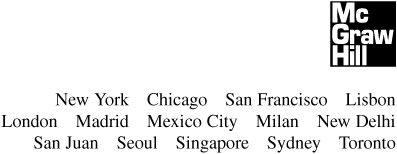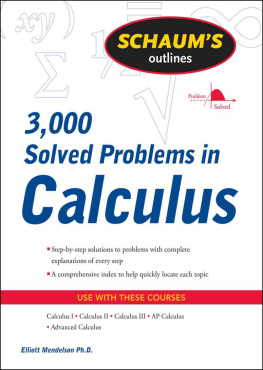SCHAUMS OUTLINE OF 3000 SOLVED PROBLEMS IN Calculus
Elliot Mendelson, Ph.D.
Professor of Mathematics
Queens College
City University of New York
Schaums Outline Series


Copyright 1988 by The McGraw-Hill Companies, Inc. All rights reserved. Printed in the United States of America. Except as permitted under the United States Copyright Act of 1976, no part of this publication may be reproduced or distributed in any form or by any means, or stored in a database or retrieval system, without the prior written permission of the publisher.
ISBN: 978-0-07-170261-4
MHID: 0-07-170261-X
The material in this eBook also appears in the print version of this title: ISBN: 978-0-07-163534-9, MHID: 0-07-163534-3.
All trademarks are trademarks of their respective owners. Rather than put a trademark symbol after every occurrence of a trademarked name, we use names in an editorial fashion only, and to the benefit of the trademark owner, with no intention of infringement of the trademark. Where such designations appear in this book, they have been printed with initial caps.
McGraw-Hill eBooks are available at special quantity discounts to use as premiums and sales promotions, or for use in corporate training programs. To contact a representative please e-mail us at bulksales@mcgraw-hill.com.
TERMS OF USE
This is a copyrighted work and The McGraw-Hill Companies, Inc. (McGraw-Hill) and its licensors reserve all rights in and to the work. Use of this work is subject to these terms. Except as permitted under the Copyright Act of 1976 and the right to store and retrieve one copy of the work, you may not decompile, disassemble, reverse engineer, reproduce, modify, create derivative works based upon, transmit, distribute, disseminate, sell, publish or sublicense the work or any part of it without McGraw-Hills prior consent. You may use the work for your own noncommercial and personal use; any other use of the work is strictly prohibited. Your right to use the work may be terminated if you fail to comply with these terms.
THE WORK IS PROVIDED AS IS. McGRAW-HILL AND ITS LICENSORS MAKE NO GUARANTEES OR WARRANTIES AS TO THE ACCURACY, ADEQUACY OR COMPLETENESS OF OR RESULTS TO BE OBTAINED FROM USING THE WORK, INCLUDING ANY INFORMATION THAT CAN BE ACCESSED THROUGH THE WORK VIA HYPERLINK OR OTHERWISE, AND EXPRESSLY DISCLAIM ANY WARRANTY, EXPRESS OR IMPLIED, INCLUDING BUT NOT LIMITED TO IMPLIED WARRANTIES OF MERCHANTABILITY OR FITNESS FOR A PARTICULAR PURPOSE. McGraw-Hill and its licensors do not warrant or guarantee that the functions contained in the work will meet your requirements or that its operation will be uninterrupted or error free. Neither McGraw-Hill nor its licensors shall be liable to you or anyone else for any inaccuracy, error or omission, regardless of cause, in the work or for any damages resulting therefrom. McGraw-Hill has no responsibility for the content of any information accessed through the work. Under no circumstances shall McGraw-Hill and/or its licensors be liable for any indirect, incidental, special, punitive, consequential or similar damages that result from the use of or inability to use the work, even if any of them has been advised of the possibility of such damages. This limitation of liability shall apply to any claim or cause whatsoever whether such claim or cause arises in contract, tort or otherwise.
CONTENTS
To the Student
This collection of solved problems covers elementary and intermediate calculus, and much of advanced calculus. We have aimed at presenting the broadest range of problems that you are likely to encounterthe old chestnuts, all the current standard types, and some not so standard.
Each chapter begins with very elementary problems. Their difficulty usually increases as the chapter progresses, but there is no uniform pattern.
It is assumed that you have available a calculus textbook, including tables for the trigonometric, logarithmic, and exponential functions. Our ordering of the chapters follows the customary order found in many textbooks, but as no two textbooks have exactly the same sequence of topics, you must expect an occasional discrepancy from the order followed in your course.
The printed solution that immediately follows a problem statement gives you all the details of one way to solve the problem. You might wish to delay consulting that solution until you have outlined an attack in your own mind. You might even disdain to read it until, with pencil and paper, you have solved the problem yourself (or failed gloriously). Used thus, 3000 Solved Problems in Calculus can almost serve as a supplement to any course in calculus, or even as an independent refresher course.
CHAPTER 1
Inequalities
1.1 Solve 3 + 2x 7.
 2x 4 [Subtract 3 from both sides. This is equivalent to adding 3 to both sides.]
2x 4 [Subtract 3 from both sides. This is equivalent to adding 3 to both sides.]
Answerx 2 [Divide both sides by 2. This is equivalent to multiplying by  .] In interval notation, the solution is the set (, 2).
.] In interval notation, the solution is the set (, 2).
1.2 Solve 5 3x 5x + 2.
 5 3x 5x + 2, 5 8x + 2 [Add 3x to both sides.], 3 8x [Subtract 2 from both sides.]
5 3x 5x + 2, 5 8x + 2 [Add 3x to both sides.], 3 8x [Subtract 2 from both sides.]
Answer [Divide both sides by 8.] In interval notation, the solution is the set (
[Divide both sides by 8.] In interval notation, the solution is the set ( , ).
, ).
1.3 Solve 7 2x + 5 9.
 7 2x + 5 9, 12 2x 4 [Subtract 5 from all terms.]
7 2x + 5 9, 12 2x 4 [Subtract 5 from all terms.]
Answer 6 x 2 [Divide by 2.] In interval notation, the solution is the set (6, 2).
1.4 Solve 3 4x 1 5.
 3 4x 1 5, 4 4x 6 [Add 1 to all terms.]
3 4x 1 5, 4 4x 6 [Add 1 to all terms.]
Answer [Divide by 4.] In interval notation, the solution is the set
[Divide by 4.] In interval notation, the solution is the set  ).
).
1.5 Solve 4 2x + 5 7.
 4 2x + 5 7, 1 2x 2 [Subtract 5.]
4 2x + 5 7, 1 2x 2 [Subtract 5.]
Answer [Divide by 2. Since 2 is negative, we must reverse the inequalities.] In interval notation, the solution is the set [1,
[Divide by 2. Since 2 is negative, we must reverse the inequalities.] In interval notation, the solution is the set [1,  ).
).
1.6 Solve  .
.







 2x 4 [Subtract 3 from both sides. This is equivalent to adding 3 to both sides.]
2x 4 [Subtract 3 from both sides. This is equivalent to adding 3 to both sides.] .] In interval notation, the solution is the set (, 2).
.] In interval notation, the solution is the set (, 2). [Divide both sides by 8.] In interval notation, the solution is the set (
[Divide both sides by 8.] In interval notation, the solution is the set ( , ).
, ). [Divide by 4.] In interval notation, the solution is the set
[Divide by 4.] In interval notation, the solution is the set  ).
). [Divide by 2. Since 2 is negative, we must reverse the inequalities.] In interval notation, the solution is the set [1,
[Divide by 2. Since 2 is negative, we must reverse the inequalities.] In interval notation, the solution is the set [1,  .
.